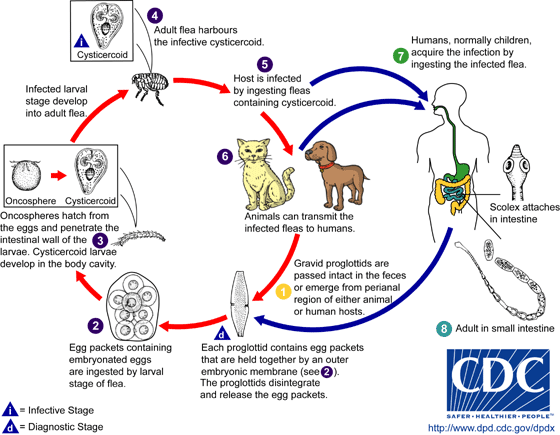Dipylidium caninum (the double-pored dog tapeworm) mainly infects dogs and cats, but is occasionally found in humans.

Gravid proglottids are passed intact in the feces or emerge from the perianal region of the host. Subsequently they release typical egg packets. On rare occasions, proglottids rupture and egg packets are seen in stool samples. Following ingestion of an egg by the intermediate host (larval stages of the dog or cat flea Ctenocephalides spp.), an oncosphere is released into the flea's intestine. The oncosphere penetrates the intestinal wall, invades the insect's hemocoel (body cavity), and develops into a cysticercoid larva. The larva develops into an adult, and the adult flea harbours the infective cysticercoid. The vertebrate host becomes infected by ingesting the adult flea containing the cysticercoid. The dog is the principal definitive host for Dipylidium caninum. Other potential hosts include cats, foxes, and humans (mostly children). Humans acquire infection by ingesting the cysticercoid contaminated flea. This can be promulgated by close contact between children and their infected pets. In the small intestine of the vertebrate host the cysticercoid develops into the adult tapeworm which reaches maturity about 1 month after infection. The adult tapeworms (measuring up to 60 cm in length and 3 mm in width) reside in the small intestine of the host, where they each attach by their scolex. They produce proglottids (or segments) which have two genital pores (hence the name "double-pored" tapeworm). The proglottids mature, become gravid, detach from the tapeworm, and migrate to the anus or are passed in the stool.
Life cycle image and information courtesy of DPDx.
For more information view the source:Center for Disease Control
Recommended Test:Full GI Panel
Recommended Product:Freedom Cleanse Restore Parasite Cleanse